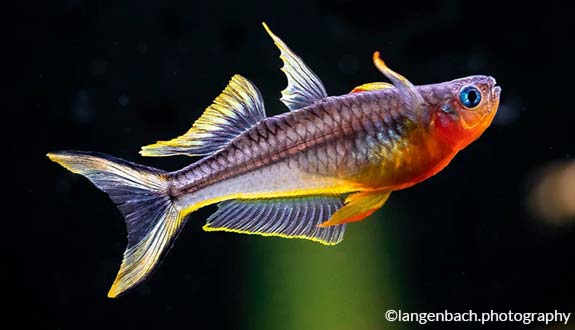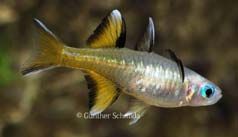

Alternative species (click on the thumbnail to see the card)
Names
Scientific name
Pseudomugil furcatus
Popondetta furcata
Popondichthys furcatus
Pseudomugil furcata
Common name
Forktail blue-eye
Forktailed Rainbowfish
Blue Eye Forktail Rainbowfish
Origin

Origin: Papua New Guinea
Biotope: Papua New Guinea
Dimorphism

Males have brighter colours (yellow stripes on all fins), are larger and have a longer dorsal fin.
Group
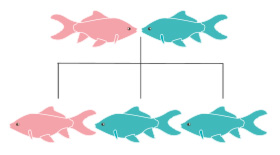
Poeciliidae
Volume

150 L / 33 imp gal / 40 US gal
Parameters

T°: 24 to 26°C or 75 to 79°F
pH: 6.8 to 7.5
Hardness: 8 to 12°dGH
Difficulty

Average
Size

Female: 4.5cm (1.6) - Male: 5.5cm (2")
Longevity

3 years
Living zone
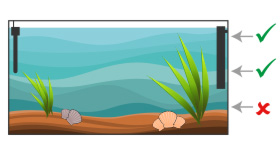
Middle and top
Individuals

14
Food
How to feed the Pseudomugil furcatus?
Food
How to feed the Pseudomugil furcatus?
Make sure that the proposed feeding is adapted to the size of its small mouth! Moreover, it only feeds on the surface. You should therefore choose floating food.
In general, prefer live or frozen prey such as artemia, microworm, daphnia, etc... Freeze-dried foods such as worms, granules or flakes will be a good addition.
Behavior
What kind of behavior does the Pseudomugil furcatus have?
Behavior
What kind of behavior does the Pseudomugil furcatus have?
Pseudomugil furcatus is a fairly lively and very active fish. It is perhaps even the most lively of the Pseudomugil. Its sociability is very good because it is perfectly peaceful. It lives in the upper part of the aquarium and rarely goes down to the bottom.
Cohabitation
Who can live with the Pseudomugil furcatus?
Cohabitation
Who can live with the Pseudomugil furcatus?
It is a gregarious fish that absolutely needs the presence of many congeners to show natural behaviour. So, you will install in your aquarium a group of at least 14 specimens, comprising 4 males and 10 females. Of course, in larger volumes, you can increase this number!
Beware of the risk of hybridization with other members of the family. For example, avoid associating it with Pseudomugil gertrudae or Pseudomugil signifier.
You can associate it with all peaceful fish of similar size. For example, Gobiidae, Cyprinidae and small Melanoteniidae will be good roommates.
We particularly recommend cohabitation with the Tateur (Tateurndina ocellicauda) to stay in the biotope Australia / New Guinea.
Breeding
How to breed the Pseudomugil furcatus?
Breeding
How to breed the Pseudomugil furcatus?
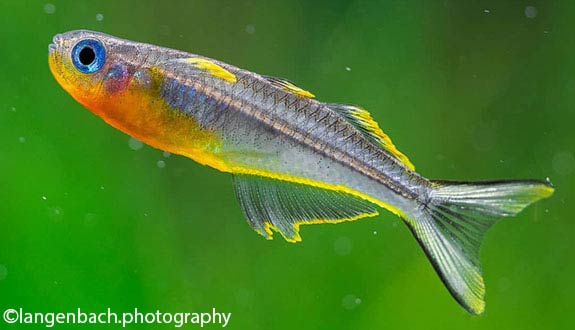
Reproduction of this species is said to be quite easy. Provide a small 50-litre (11 Imp Gal / 13 US Gal) laying aquarium in which you will install a filter and an immersion heater. The water must be exactly the same as in the main aquarium. As a laying medium, use clumps of fine-leaved plants such as Java moss or mops at the bottom of the tank. Plant the rest of the aquarium densely and use floating plants.
Introduce one male and two or three females. After spawning, the female will lay eggs in several places for several days. After spawning, remove the parents as they will eat their eggs.
The eggs cling to plants with filaments. Incubation is quite long, and you will have to wait 2 to 3 weeks to see your first fry. After hatching, the young are so small that they are hard to see. It is only after 6 weeks of growth that they will start to look like their parent. Just like the adults, they are sensitive to old water and you will need to make small water changes regularly. To monitor for any abnormality in this respect, you will notice that your fry have a head that "bends" from the back line. One water change is sufficient to solve the problem. Take advantage of the water change to siphon off the bottom of the tank and clean up any food remains.
Feeding the fry: infusing then nauplias of artemia. Distribute small meals twice a day.
Its aquarium
Which aquarium for the Pseudomugil furcatus?
Its aquarium
Which aquarium for the Pseudomugil furcatus?
First of all, your aquarium must be absolutely mature and stable at the parameter levels. Indeed, this fish does not tolerate variations in the chemical parameters of the water. Pay particular attention to the nitrite (NO2) and nitrate (NO3) levels to which it is particularly sensitive. The renewal of the water is therefore a central point of its maintenance (they do not like to evolve in old water). You will have to renew 10% of the water every week, using new water with identical parameters. Make the change slowly.
Good filtration will not only ensure satisfactory water quality, but also a moderate current and good oxygenation of the water.
On the decor side, plant densely but still leave enough room for swimming. Indeed, this fish with a lively temperament likes to swim and move around easily. It will particularly appreciate the presence of floating plants that will delicately diffuse the light in the tank. Complete your decor with rocks.
Good To know
Find all additional information!
Good To know
Find all additional information!
They may seem washed out at the point of sale, but rest assured, once they are well installed in your home and in good conditions, they will regain their lustre!
As it is sensitive to changes in water parameters, acclimatise it slowly and gently.
Yours photos!
Comments
Sort by:
Please login to post comments
